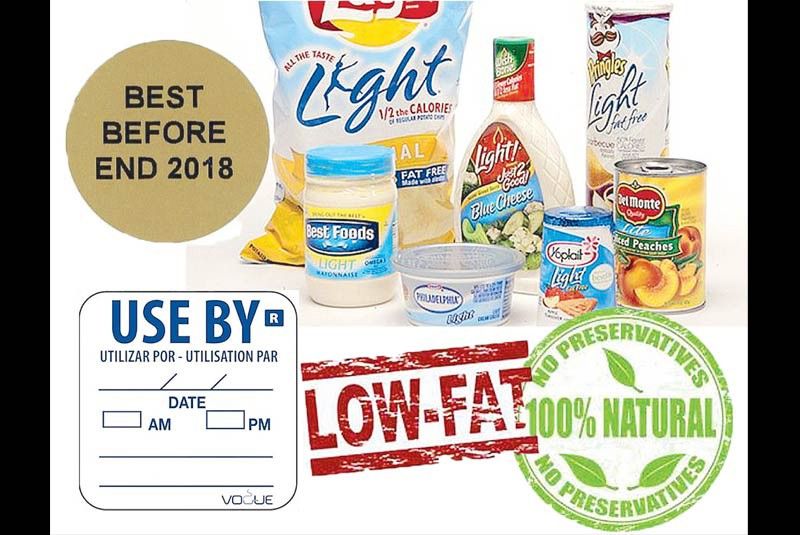What you ought to know about food labels but never bothered to ask

Do you really bother to read product labels when you do your groceries? Fat chance you do ’coz you’re probably always in a rush to get your grocery chores done. But wait — stop, look, and read! Read this basic legalese that may help you next time you find yourself browsing the supermarket shelves.
Shortly after the holiday season, some supermarkets went on sale — prices of mostly holiday goodies were at 50 to 75-percent off. But here’s the catch: The products are expiring in a week or two! If you don’t see any expiry date on the label, you should come across the words “best before” or “use by.” It pays to know all this basic “labelese.”
Livewell/Goodfood warns us not to use a product after the end of the “use by” date — even if it still happens to look okay and does not smell funny (sniffing is no fool-proof test), because doing so could put your health (or that of your family) at risk.
If the “use by” date is tomorrow, please use the product by the end of tomorrow (as there’ll be no more tomorrows after this), even if you just opened it and the label says, “Eat within a week of opening.”
However, if it’s frozen food, its life can still be extended beyond the “use by” date, but make sure you follow strictly the instructions on the pack like, “Cook from frozen” or “Defrost thoroughly before use and use within 24 hours.”
On the other hand, “best before” is about the quality of the product and not about safety. When it’s past the expiration date, it doesn’t mean that the food will be harmful; it’s just that it might begin to lose its flavor or texture. So, don’t toss a “still good” product into the waste bin.
Take eggs, for instance, they must reach the consumer within 21 days from the time they were laid (known as the “sell-by” date, the store’s guide as to how long to display the product and when to pull it out). After this date, the quality of the eggs will deteriorate — besides, if the eggs harbor salmonella bacteria, these could multiply at an alarming rate.
Just to clarify, the expiration date is usually printed in the standard MM/DD/YYYY (month/day/year). Make no mistake about it: The month always comes before the day.
Indeed, food labels should not be taken lightly. Like, if it says light, what does it mean? Earl Mindell’s Safe Eating says: “This usually means either one-third fewer calories than the regular product (which could have a lot more than you thought) or that it doesn’t contain more than 40 calories per serving (which could be a lot less than you thought). But it can also mean lighter in syrup density, or color, or salt content. Though the label must state this, consumers don’t often read the fine print and just assume that all light — or lite — products are low in calories.”
And what does lean mean? When referring to meat or poultry, it usually means 25-percent less calories vis-a-vis the regular product — or it could refer to the salt or breading.
For those perpetually on a diet or those who have health concerns, here’s the lowdown on the “low” labels. “Low fat” means the food item is at least 25-percent less fat than a similar product. And “low sodium” means the product can have no more than 140 mg. per serving.
For those who think salt is a sin and those with high blood presssure or cardiovascular problems, take note that “unsalted,” “salt free,” “no salt added” mean that though “no salt was added during processing, the product can still contain substantial amounts of sodium.”
Naturally, you would want to know what “natural” or “all natural” means. Mindell says, “When used on a meat or poultry label, ‘natural’ means that the product doesn’t contain any artificial ingredients or chemical preservatives. But on other products, those whose labels are regulated by the FDA (most supermarket food), ‘natural’ has no legal definition and is used by manufacturers to make people think the product is totally free of additives and chemicals — which is rarely, if ever, the case.”
What does it mean when something is “naturally sweetened”? Again, this has no legal definition, and is often used only as a marketing ploy. So, even if it’s sweetened naturally by honey, brown sugar or corn syrup, it’s not necessarily lower in calories — or good for your health!
And to cap this on a sweet note: What does “sugarless” or “sugar free” mean? Mindell tells us, “This means free of sugar (sucrose), but not other sweeteners (mannitol, sorbitol, and fructose, for example), and therefore such products can contain just as many calories as those with sugar. If so, the fine print must state this, or something to the effect of the product’s usefulness only in not promoting tooth decay. Regrettably, not many buyers take the time to read the fine print.”
Happy — and safe and healthy eating — to one and all!



















